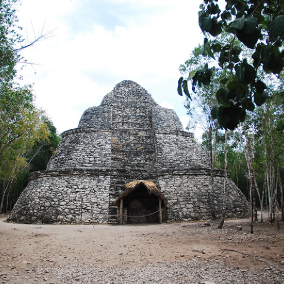Deep within the Quintana Roo jungle lies Cobá, an ancient Maya city perfectly preserved and considered the largest pre-Hispanic settlement on the Yucatán Peninsula, rivaling in importance with Chichén Itzá. Despite its vast extent of 70 square kilometers, only 5% of its structures have been discovered.
Cobá was interconnected with other cities through a network of 45 long roads of white stone called "sacbes," which shone amid the jungle. Nowadays, visitors can traverse these ancient causeways by bicycle or tricycle with a driver, as some structures are separated by more than two kilometers.
The impressive Nohoch Mul pyramid stands out among Cobá's structures, with its 42-meter height, making it the tallest on the peninsula. Visitors can ascend it via a steep staircase, aided by a rope. From the top, one gets a breathtaking view of the surrounding dense vegetation, revealing the antiquity of this city and how nature has reclaimed it.
In addition to the pyramid, other notable structures include the ball court, the Temple of the Frescoes, and various stelae, such as stela number 1, which mentions the year 2012, interpreted as the beginning of a new era. The ruins are grouped into zones like Cobá, Nohoch Mul, the Paintings Group, Macanxoc, and the Observatory.
For a complete experience, near the archaeological site lies the Eco-village Pac-Chen, where one can learn about the customs of the Maya ethnicity, as well as cenotes to enjoy a refreshing dip in the "underworld."
Cobá, which once housed 50,000 people, has its first recorded settlements between 100 B.C. and 300 A.D. The name Cobá means "Abundant Water" or "Turbid Water," referring to the five lakes that supplied the Maya metropolis.
To reach Cobá, the archaeological site can be accessed by public transport, bus, or private car from Tulum, Cancun, and Playa del Carmen.

